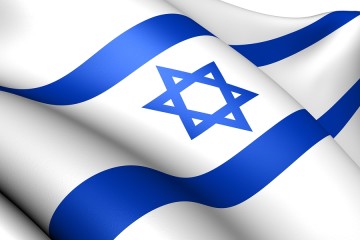In Land of 43% Unemployment, Forgotten Gaza Crisis Rages On

©2015 Bloomberg News
NRVZL66JTSEK
(Bloomberg) — They roll by on flatbed trucks, 12-foot missiles bearing the names of Hamas commanders killed in an Israeli air strike: the Shamalah, the Attar.
The scene is a parade through central Gaza City this month on the one-year anniversary of the most recent of three Hamas- Israel wars. The locally-made missiles, with a range exceeding the 45 miles to Tel Aviv, are hailed by a Hamas official masked in a red scarf as the crowd cheers.
It is also 10 years since Israel withdrew its settlers and soldiers from this Palestinian coastal strip, a moment to take stock of how much has changed since Israel left the area in the hands of the Palestinian Authority and optimism briefly blossomed.
Then investors spun visions of a Mediterranean Singapore. Marriott International Inc. considered plans for a beachfront resort, and the European Union built high-rise towers. Even Israel played along, putting up a huge modern border terminal for the expected traffic.
Today there is little traffic and less optimism. The Palestinian Authority was driven out by its rival, Hamas, an Islamist group that rejects Israel’s existence. Today Gaza is squeezed by Hamas on the one hand and its Israeli and Egyptian neighbors on the other, bereft of politics or an economy. The Palestinians face international apathy as the rise of Islamic State and other crises supplant theirs at the heart of the Middle East conflicts. No longer able to smuggle Iranian missiles through Egypt — both countries have removed their support — Hamas makes its own.
Bigger Problems
“We’re talking about a region that simply has bigger problems now,” says Mkhaimar Abusada, who teaches political science at Gaza’s Al-Azhar University. For Palestinians who thought life would be better after the Israelis left, “the disengagement has backfired badly.”
Motasem Abu Asser lives the difficulty every day. He rouses his four children in the one room left standing from their home pulverized by Israeli tanks a year ago.
“There are thousands of families like us,” says 31-year- old Abu-Asser, an unemployed vegetable hawker, shuffling through the rubble.
Gaza’s housing minister presided over a ceremony today marking the first time since last year’s war that a $5.4 billion fund pledged by international donors could be used to start rebuilding 18,000 homes demolished in the fighting. Foreign governments had held back the aid, seeking guarantees Hamas would not divert the money to rebuild tunnels and other structures used to attack Israel.
Gaza’s misery has always been fraught with the political disputes it encapsulates. For those seeking to indict Israel, Gaza is portrayed as one of the worst spots on earth. It is not. Seven decades of United Nations-provided food, medical care and education have made Gaza more literate and healthier than much of the developing world.
No Crisis
Meanwhile, Israeli officials and their defenders repeat the phrase, “There is no humanitarian crisis in Gaza.” But there is. After last year’s war, 100,000 Gazans still do not have homes. And none of the 1.8 million inhabitants, most of them refugees from what is today Israel, have stability.
The World Bank reported in May that Gaza’s GDP shrank by 15 percent in 2014 because Egypt closed off smuggler tunnels from Sinai and Israel invaded last summer. Real per capita income is 31 percent lower than it was 20 years ago. Some 80 percent of Gazans receive some refugee aid. Unemployment stands at 43 percent.
Gaza resists simple description. Hamas sought to impose more Sharia law but pulled back amid opposition from human- rights groups and the half of the population aligned with Palestinian President Mahmoud Abbas’ more secular Fatah party. Schools require teenage girls to wear long skirts and hijab head coverings but women who leave their heads bare generally suffer no consequences. This is not Afghanistan under the Taliban.
Steak au Poivre
The territory retains a middle class of business owners, doctors and other professionals who dine on steak au poivre at the tony Roots Club restaurant and drive late-model cars.
“I live a comfortable life but there’s a lack of stability here,” says Na’el al-Masri, a 32-year-old dentist.
Radical Salafist groups, some aligned with Islamic State and al-Qaeda, occasionally bomb music stores and Internet cafes and threaten the few tiny Christian institutions. That has led to a crackdown by Hamas security forces, placing them in the peculiar position of defenders against radical Islam.
“Hamas is persecuting us and arresting us, but we are doing our best to avoid a war with them and focus on fighting the Jews,” said Abu Mohamed el-Ansari, 27, wearing the traditional gray robe and long beard of the Salafists.
Israel has eased some restrictions, admitting some building materials previously withheld because Hamas might take them to rebuild tunnels it used to attack Israel.
Entry Permits
Israel has increased the number of supply trucks let into Gaza to 800 a day from 400 and authorized the export of produce and fish to the Fatah-dominated West Bank. It also raised the number of entry permits to Israel for Gaza business people to 5,000 from 3,000.
“We will try to do our best to find creative solutions but not more than that,” Colonel Grisha Yakubovich of the Defense Ministry said in an interview at his office in Tel Aviv.
Gisha, an Israeli group that seeks freedom of movement for the Palestinians, says such solutions add up to little.
“The perception is that more political capital can be gained by imposing hardships on the people in Gaza rather than easing the conditions there,” said Eitan Diamond, Gisha’s executive director.
When Israel pulled out of Gaza in 2005 it left its 21 settlements as piles of rubble. Hamas has turned those areas into a university, amusement park, orange groves and militant training bases. Missiles are made and tunnels rebuilt as Palestinians here, increasingly separate from their brethren in the West Bank, say another battle with Israel is inevitable.
Managed Conflict
Many in Israel, persuaded there is no partner for a peaceful two-state solution, agree. The conflict cannot end, they say, so it must be managed.
Amid the war-torn landscape, Palestinians in Gaza haven’t given up, however. They troll the Internet, watch their satellite TV screens and look warily at the chaos and suffering in Syria, Iraq and Egypt. Gaza’s tiny size and isolation have strengthened the clans of extended families who take care of each other, according to Omer Shaban, director of the Pal-Think for Strategic Studies research institute. Predictions of economic doom, he says, are exaggerated.
“There are social ties in Gaza that are hard to find in other areas of the world,” Shaban says. “People are poor and conditions are hard, but people stick together and will manage to survive.”
–With assistance from Fadwa Hodali in Ramallah.
To contact the reporters on this story: Jonathan Ferziger in Tel Aviv at jferziger@bloomberg.net; Saud Abu Ramadan in Gaza City at sramadan@bloomberg.net To contact the editors responsible for this story: Alaa Shahine at asalha@bloomberg.net Ethan Bronner, Melinda Grenier, Stuart Biggs







No Comment